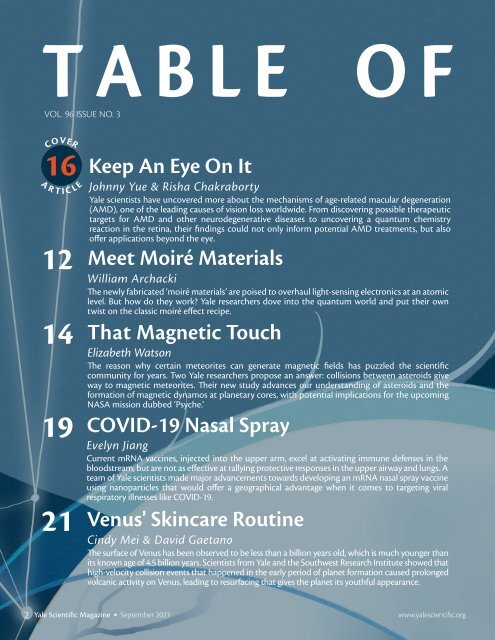YSM Issue 96.3
You also want an ePaper? Increase the reach of your titles
YUMPU automatically turns print PDFs into web optimized ePapers that Google loves.
TABLE OF<br />
VOL. 96 ISSUE NO. 3<br />
COVER<br />
16<br />
A R T<br />
I C L E<br />
Keep An Eye On It<br />
Johnny Yue & Risha Chakraborty<br />
Yale scientists have uncovered more about the mechanisms of age-related macular degeneration<br />
(AMD), one of the leading causes of vision loss worldwide. From discovering possible therapeutic<br />
targets for AMD and other neurodegenerative diseases to uncovering a quantum chemistry<br />
reaction in the retina, their findings could not only inform potential AMD treatments, but also<br />
offer applications beyond the eye.<br />
12 Meet Moiré Materials<br />
William Archacki<br />
The newly fabricated ‘moiré materials’ are poised to overhaul light-sensing electronics at an atomic<br />
level. But how do they work? Yale researchers dove into the quantum world and put their own<br />
twist on the classic moiré effect recipe.<br />
14 That Magnetic Touch<br />
Elizabeth Watson<br />
The reason why certain meteorites can generate magnetic fields has puzzled the scientific<br />
community for years. Two Yale researchers propose an answer: collisions between asteroids give<br />
way to magnetic meteorites. Their new study advances our understanding of asteroids and the<br />
formation of magnetic dynamos at planetary cores, with potential implications for the upcoming<br />
NASA mission dubbed ‘Psyche.’<br />
19 COVID-19 Nasal Spray<br />
Evelyn Jiang<br />
Current mRNA vaccines, injected into the upper arm, excel at activating immune defenses in the<br />
bloodstream, but are not as effective at rallying protective responses in the upper airway and lungs. A<br />
team of Yale scientists made major advancements towards developing an mRNA nasal spray vaccine<br />
using nanoparticles that would offer a geographical advantage when it comes to targeting viral<br />
respiratory illnesses like COVID-19.<br />
21 Venus' Skincare Routine<br />
Cindy Mei & David Gaetano<br />
The surface of Venus has been observed to be less than a billion years old, which is much younger than<br />
its known age of 4.5 billion years. Scientists from Yale and the Southwest Research Institute showed that<br />
high-velocity collision events that happened in the early period of planet formation caused prolonged<br />
volcanic activity on Venus, leading to resurfacing that gives the planet its youthful appearance.<br />
2 Yale Scientific Magazine September 2023 www.yalescientific.org

















